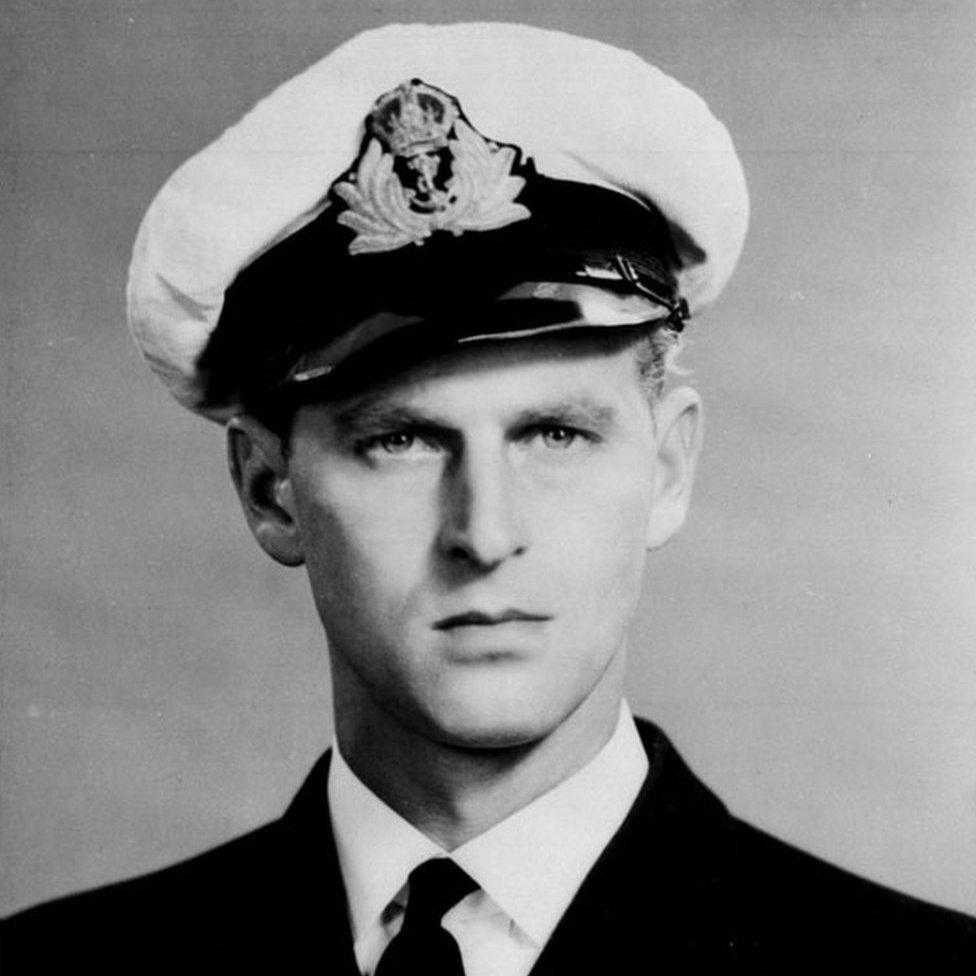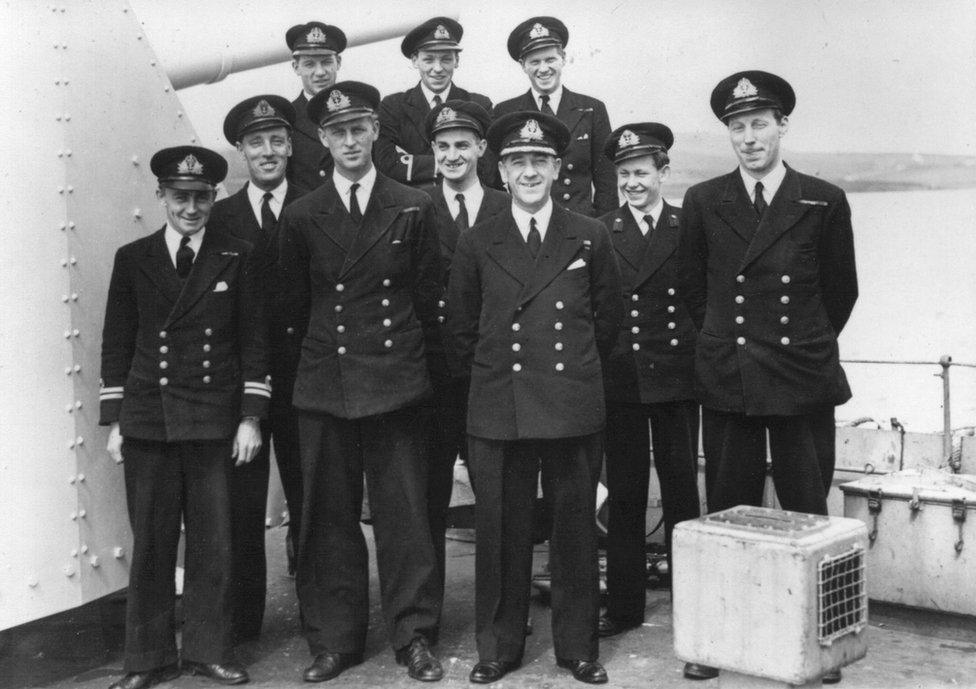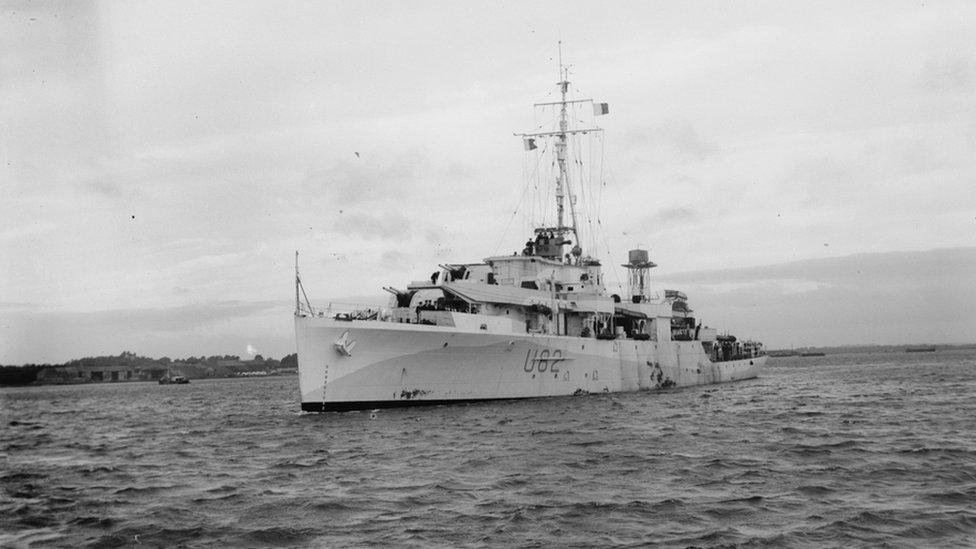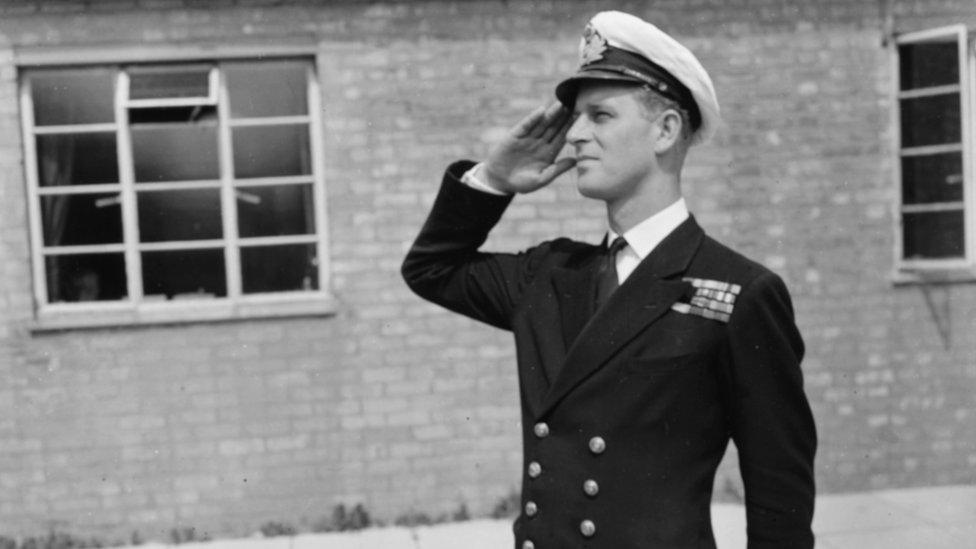Prince Philip: How the Royal Navy shaped the Duke of Edinburgh
- Published
Prince Philip speaks about his navy experiences
The Duke of Edinburgh was an 18-month-old exile when he had his first brush with the Royal Navy.
In 1922, he was carried on board a British warship in a makeshift cot fashioned from an orange crate, after the Greek military government had banished his family.
So it might have seemed as if he was destined for a life at sea.
After all, the duke's maternal grandfather, Prince Louis of Battenberg, had been admiral of the fleet and first sea lord - although he had to resign in 1914, amid a wave of anti-German feeling.
But years after that perilous evacuation, as he left his Scottish boarding school, Gordonstoun, with Britain on the brink of war with Germany, Philip expressed a wish to join the RAF.

Philip served with distinction during World War Two

It was the intervention of his uncle Louis "Dickie" Mountbatten, then captain of HMS Kelly, that persuaded him to follow his family's long naval tradition.
And although the role of a fighter pilot was a more natural fit for his temperament, Prince Philip told the BBC in 2002, his chances of surviving the War would have been greatly reduced.
He took the usual path of an aspiring naval officer, entering Britannia Royal Naval College, Dartmouth, as a cadet and being commissioned as a midshipman, in January 1940.
'Bloody fool'
Philip excelled at Dartmouth, winning the King's Dirk, for the best all-round cadet of the term, and a prize for the best cadet in college.
And when King George VI and Queen Elizabeth, together with their daughters, Elizabeth and Margaret, paid an official visit to the college, in July 1939, Philip was given the task of escorting the young princesses.
Their governess, Marion Crawford, later recollected he had "showed off a great deal".
But he evidently made quite an impression on the 13-year-old Elizabeth.
Cadets in rowing boats escorted the royal yacht, the Victoria and Albert, when it sailed from Dartmouth. But Philip continued rowing in its wake long after the others had dropped out, turning round only when ordered to by the increasingly exasperated King, who referred to him as "a bloody fool".
Greece remained neutral at the outbreak of war.
And Philip, as a potential heir to its throne and technically still a foreigner, was initially kept away from battle zones.
But in January 1940, Cdr Mountbatten pulled some strings and got his nephew posted to the battleship HMS Ramillies, escorting Australian troop convoys in the Indian Ocean.

Lord Mountbatten was instrumental in persuading his nephew to join the navy
Then, after short spells on HMS Kent and HMS Shropshire, Philip transferred to the battleship HMS Valiant.
With Greece having entered the War on the Allied side, it was decided he could now serve in the Mediterranean theatre.
He was in the Battle of Crete and mentioned in dispatches for his skill controlling the Valiant's searchlights during the Battle of Cape Matapan, which played a major role in the destruction of the Italian fleet.
Philip's industriousness was not in question.
As he returned to England, on RMS Empress of Russia, the troopship found itself without stokers.
So Philip himself went down to the boiler room and shovelled coal for so long his blistered hands could not hold a fork.
Promotion followed, and a posting to the destroyer HMS Wallace, on hazardous convoy duty in the North Sea.


At 21, Philip was again promoted, to second-in-command of the Wallace, making him one of the youngest first lieutenants in the Royal Navy.
And in 1943, he returned as part of the support for the Allied invasion of Sicily.
But German dive bombers damaged the Wallace in a night-time attack.
And the crew feared the enemy would return in greater numbers and finish them off.
So Philip proposed launching a makeshift raft, equipped with smoke floats, which in the darkness fooled the German bomb aimers into thinking this was the damaged destroyer.
"Philip saved our lives that night," one of the Wallace's crew, Harry Hargreaves, told the Observer in 2003.
"He was always very courageous and resourceful, and thought very quickly."

After the War, Philip was reunited with air crews he had helped rescue on HMS Whelp
In 1945, Philip was transferred to the destroyer HMS Whelp, supporting air raids on Japanese shore installations.
He was involved in the rescue of British air crew shot down by Japanese fighters and was in Tokyo Bay to witness the surrender of the Japanese forces.

The duke showed his new wife around HMS Chequers in 1949

In 1947, the War finally over, Philip married Princess Elizabeth.
When he landed a role on HMS Chequers, a destroyer based in Malta, there came happy carefree times for both of them.
And in 1950, after being promoted to lieutenant commander, the duke finally took command of his own ship, the frigate HMS Magpie.
But within a year, his naval career was over.

Prince Philip's first command was HMS Magpie
He found himself having to support Princess Elizabeth when she took on more royal duties as the King's health declined.
"At that time, I had not thought that was going to be the end of a sort of naval career," he later said.
"And that sort of crept upon me. And it became more and more obvious that I could not go back to it.
"But it's no good regretting things. It simply didn't happen.
"And I've been doing other things instead."
'Walked it'
But for some, there was little doubt Philip had had the potential to rise to the very top of the Royal Navy.
The late Terry Lewin, who served alongside Philip when both were junior officers, went on to become first sea lord.
And it was once suggested to him had the duke remained in the navy, they might have been competing for the top job.
"I don't think the competition would have been very strong," Lord Lewin later told the BBC.
"He would have walked it."
Suffer fools
Yet as an officer, Philip never achieved the level of affection Lord Mountbatten managed.
He was notoriously not one to suffer fools gladly.
And one junior sailor on HMS Magpie said he never wanted to serve under him again.
But Philip is also remembered as an immensely capable officer who drove himself as hard as his men and remained cool in moments of crisis.
And although the duke's royal duties became his first priority, he maintained his interest in the Royal Navy - and used his position to support the preservation of Britain's maritime heritage.
In 2011, the Queen appointed him lord high admiral, a post that has existed since the 14th Century.

Philip's love of the sea remained after he left the Royal Navy

And the duke maintained his love of ships and the sea, which remained a constant source of fascination to him.
"The environment is completely different to anything you'll find on land," he once said.
"You're at sea and exposed to the elements in a way you never are ashore.
"At sea you're in a cockleshell in this enormous expanse of the ocean.
"So that tends to cut you down in size a bit."


All photographs are copyrighted.